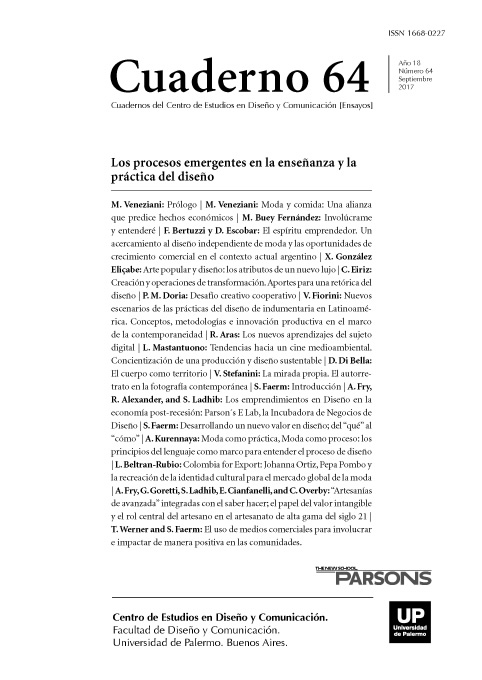Fashion as practice, fashion as process: using principles of language as a framework for understanding the design process
Abstract
How do creative impulses and lived realities interact and inform one another throughout the design process? This project examines the mechanics of the creative process by observing the work of three graduate fashion design students as a first step toward understanding the nature of the design process and the symbiosis between object and process, using ideas borrowed from modern linguistic theory as the starting point for investigation. Referencing Cholachatpino’s et al. (2002) categorization of the microsubjective order of the fashion process as “a dynamic process and not a linear continuum”, along with Ingold and Hallam’s (2009) notion of cultural improvisation and related theories from the field of linguistic anthropology, this paper argues that the fashion design process is open to the kind of improvisation inherent in any ongoing lived experience, the final product representing a culmination of the ideas, desires, decisions, obstacles, and other circumstances shaping its production. Ideas are not translated into their material form in a fluid and uncomplicated manner; in fact, there are many intervening forms of disruption, diversion, reformulation, and rearticulation, not unlike our everyday use of language in conversation. Reconsidering the design process with an eye toward explaining its collective, nonlinear, and experimental nature allows us to recognize that design has the potential to inform us about society and give us the tools to actively change it.
References
Becker, H. S. (2008). Art worlds (2nd ed.). Berkeley, CA: University of California Press.
Bourdieu, P. (1993). The field of cultural production: Essays on art and literature. R. Johnson (Ed.). New York, NY: Columbia University Press.
Chafe, W., ed. (1980). Preface to Volume III. In The pear stories: Cognitive, cultural, and linguistic aspects of narrative production. Norwood, NJ: Ablex.
Cholachatpinyo, A., Padgett, I., Crocker, M., & Fletcher, B. (2002a). A conceptual model of the fashion process - Part 1: The fashion transformation process model. Journal of Fashion Marketing and Management, 6, 11-23.
Cholachatpinyo, A., Padgett, I., Crocker, M., & Fletcher, B. (2002b). A conceptual model of the fashion process - Part 2: An empirical investigation of the micro-subjective level. Journal of Fashion Marketing and Management, 6, 24-34.
Weinstein, J. I. (2009). The market in Plato’s Republic. Classical Philology, 104, 439–58. Ingold, T. & E. Hallam. (2008). Creativity and cultural improvisation: An introduction. In T. Ingold & H. Hallam (Eds.), Creativity and Cultural Improvisation (pp. 1-24). Paris: Berg.
Keane, W. (2003). Semiotics and the social analysis of material things. Language & Communication, 23, 409-425. Kuspit, D.B. (1993). The Cult of the avant-garde artist. Cambridge: Cambridge University Press. Liddicoat, A.J. (2007). An introduction to conversation analysis. London; New York, NY: Continuum.
McRobbie, A. (1998). British fashion design: Rag trade or image industry? London; New York, NY: Routledge. MFA design student (1), personal communication, October 27, 2010. MFA design student (2), personal communication, November 4, 2010. MFA design student (3), personal communication, November 4, 2010.
Ono, T., & Thompson, S.A. (1995). What can conversation tell us about syntax? In P. W. Davis (Ed.), Alternative Linguistics: Descriptive and Theoretical Modes (213-271). Amsterdam: John Benjamins.
Parsons The New School for Design. (2010). Fashion Design and Society (MFA) Curriculum. Accessed October 18, 2010. http://www.newschool.edu/parsons/mfa-fashion-designsociety-curriculum/
Salzmann, Z. (1998). Introducing linguistic anthropology. In Language, Culture, and Society: An Introduction to Linguistic Anthropology (pp. 1-26). Boulder, CO: Westview Press.
Singerman, H. (1999). Art subjects: Making artists in the American university. Berkeley, CA; Los Angeles, CA: University of California Press.
Thornton, S. (2009). Seven days in the art world. New York, NY: W.W. Norton & Co.
Los autores/as que publiquen en esta revista ceden los derechos de autor y de publicación a "Cuadernos del Centro de Estudios de Diseño y Comunicación", Aceptando el registro de su trabajo bajo una licencia de atribución de Creative Commons, que permite a terceros utilizar lo publicado siempre que de el crédito pertinente a los autores y a esta revista.


